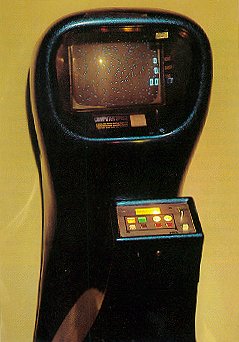The Army's version has realistic silhouettes of both enemy and friendly tanks, helicopters and armored personnel carriers. Using realistic aiming coordinates, a player has to pick the right weapon for a target, select the right ammunition and rate of fire, estimate the range, and destroy the target before it gets him, in anywhere from ten to 25 seconds.
"We've got the scoring algorithm designed to reward him for getting hits rapidly, and for destroying the most dangerous target first, and it subtracts points from his score if he fires at a friendly vehicle," Major Robinson says. "When we demonstrated the game at an armor conference at Fort Knox this spring, one of the generals who saw it said we should have a fist come out and punch the guy in the head if he's stupid enough to fire at a friendly vehicle."
Like arcade games. Army Battlezone gets more difficult as a player improves. "That seems to be the psychology behind Atari," the Major muses. "You never can win, and you always can get better." The Army has not yet tested the game, but has laid out a careful program of research in the field, to establish whether skills acquired playing the game can be transferred to military training. If they can, the Army already has its eyes on other games which might be modified to train air defense missile gunners and tank crews. "I am not a programmer or design technician," Robinson says. "I'm an armored cavalry officer and damned proud of it. But I've got a gut feeling that you can take these machines and put them in every company-sized unit in the army and get a lot of training value out of it."
Training in many-channeled thinking
At Williams Air Force Base near Phoenix, where psychologists have had a chance to study pilots trained in the multimillion-dollar computer simulator for the newest fighters in the Air Force inventory, the AIO and the FIG, arcade games are also viewed as potentially valuable.
Dr. Thomas Longridge, at the Human Resources Laboratory on the base, is using an aircraft carrier landing game for research on pilot judgment. He sees the array of information that players of some arcade games cope with as requiring skills like the rapid information processing performed by fighter pilots with video displays in their cockpits. And he thinks the games, like simulators, may train people in a kind of "multiplex," many-channeled thinking that Air Force psychologists would like to understand better. "We're
|
| interested in microprocessor-based part-task trainers," says Dr. Longridge, "as an alternative to the multimillion-dollar monster full-mission simulators the Air Force is buying now, and the extent to which you can accomplish similar kinds of- training." The distinction between computer games and computer simulators is blurring here, and in many other places where small, inexpensive microcomputers are taking over tasks that required huge mainframe computers a few years ago. Home computers have more versatility than most people know what to do with. One Atari engineer calls them "solutions in search of a problem." Already, however, they have begun to make the distinction between playing and learning a little hard to draw. An example of this is a home computer game that simulates the political economy of an ancient kingdom: You have a ten-year reign as the king and you have so much grain, so many people and so much land. You can 'buy or sell land for grain but you can't plant more acres than you have people to work at farming them. If you don't feed your people enough, they start to die. If they die, you can't plant as much grain anymore, and you may get into a downward spiral. But if you plant too much and store it, rats eat some of it, and |


